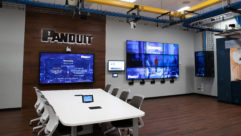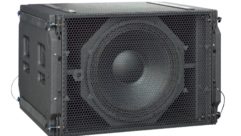
SVC: What’s been happening at Excel AV Group lately?
Kevin Crow: Well, things have been going great. We’re up quite a bit over last year revenue-wise. We’ve had some unique systems that we’ve put in this year—very, very challenging ones for sure, but we very much appreciate all of our networking partners and our manufacturers that have been supporting us. PowerSoft is definitely in that mix.
I’ve always liked Lutheran churches for having some very interesting architecture. They get very creative with their buildings. Describe Good Shepherd Lutheran Church. What worship style do they have?
I think they get a little too creative at times with their architecture. This is just nothing more than a giant concrete brick box, so acoustically, it was a challenge. They certainly did not want to add acoustical treatments because they have a traditional choir as well as [a contemporary service], which is common now. A lot of churches are moving in that direction.
We analyzed the room and we looked at how to best design a new loudspeaker system and came up with what we really needed: a dual system. One for spoken word, so that the sound was localized for spoken word from the front. And then one from the music area—which was actually in the back of the room—that would be localized for that so that the sound would sound like it was coming from the right direction. One of the biggest problems that I think they had with their previous system was that it just didn’t make sense and it didn’t sound right—especially for the musicians being time-delayed.
I noticed in some of the pictures they have brick walls?
Yeah. It’s all brick and it’s all hard surface. It’s terrible. It’s probably a three-and-a-half to four-second reverb-timed room.
I figured I almost don’t have to ask how the acoustics are in there. They have kind of an interesting layout I think. Where is the sound control point located?
Well, what we did is—we’ve been doing a lot of this in these types of churches in the last few year. It is called an easy-based system for spoken word input. So all of the common, everyday inputs like the wireless for the pastor, the alter mic, podium mic, that type of thing, goes through what we call an easy mix. We can simply use an iPad or a tablet to control it and give the client a very narrow volume window. And then when it comes to the music inputs, we have an Allen & Heath Qu-24 digital mixer that is in the actual music area. They don’t have a dedicated sound person, but they do have a desk in the music area with the mixer on it.
I would think that one of the things that they might have to get used to would be the physical separation between the choir and the altar and the front of house mixer.
Right. And in this case, this is very common where the music leader just manages sort of the spoken word and the music levels. But because the easy mix is wireless for the spoken word inputs, that tablet or iPad can be anywhere in the room. They could actually have it up front if they wanted, so it really doesn’t matter.
Where is the man behind the curtain? Where is all of the rack equipment? Is that stashed in a closet somewhere or is that kept close by?
Because of the advancements in technology, the footprint for a lot of this equipment is drastically reduced. We do have the equipment in the music area underneath the desk and the cabinetry, and it runs all of it. Thanks to PowerSoft, we’re able to power an entire sound system with one amplifier. It’s pretty incredible.
Yeah. I would think that would help in diagnostics, too. If anything does go wrong, it’s going to be easier to track down the trouble with everything right there with the operator. And they have separate front and rear sound systems. That seems like a fairly unusual situation.
You know, it is unusual. I would say a very small percentage of rooms are like this where you’ve got the music area so far away from the spoken word or the altar area. So because it’s so far away, it doesn’t make sense to have one system firing in essentially the wrong direction. It isn’t necessarily two systems, but it is two-loudspeaker-localized points of origin. We have the Fulcrum DX-8s that do the spoken word, and that is localized to the front. And then we have the Fulcrum CX-1526 speakers that are located just above the music area so that the music is localized to their source. Actually it’s the right way to do it from a loudspeaker design standpoint, but yes, it is unconventional for sure.
It’s going to mean a more involved installation and a little more cabling, but on the control, you have ultimate versatility.

If you want to fall asleep fast, you can look up on Wikipedia sound localization and read all you want about how to properly do it. I think that a lot of people make a mistake in these kinds of rooms and put in speakers in the front when the sound source is in the back and that doesn’t really make sense to the ear. So it’s the right way to do it, I think. And what’s amazing is we’re able to power this entire system with one amplifier from Powersoft.
And that’s the M50Q amp. Why did you decide on that one?
You know, we do a lot of the M series from Powersoft. From a dollar-to-wattage stand- point, you can’t beat it. We’re running not only the mains—the DX8s—for the music area with the Fulcrum CX, but we’re also power- ing the subwoofer with it. To get a full system coming out of a half-rack-space amp like that, it blows me away, really. I never thought I’d see such a thing. Years ago we used to do so many amplifiers compared to what we do now. From time to time, with some of our system designs, we’ll use the Powersoft amps that have the integrated DSP. That brings even more value to it because we’re able to tune an entire system with the amplifier and DSP integrated.
Amps and DSP have come a long way, and for this setup, having it all in the minimum footprint is a real plus. It would appear from that space that the choir monitoring might be an interesting problem. How does that work? Do they use monitor wedges?
They do. We have a couple of the Turbo- sound monitor wedges; you know, very minimal though, one or two at very low levels. We put those in front of the choir and then try to train the customer that less is more. They don’t always hear that, but they hear it in feedback if they don’t hear it.
I think the choir is not going to be scrutinizing the mix like a bunch of audiophiles, but as long as they can keep time that’s what they need.
They can tune and hear the music, and thank God they’re not drummers who have ears that are blown away.
There’s a lot of music in this church, so how do the musicians do their monitoring?
This is one of the battles that I think a lot of integration companies that specialize in churches deal with. Certainly my company deals with this on a very, very regular basis. How do you reduce the stage volume or the music area volume levels to the point where it’s manageable? The biggest problem areas are drummers, bass players, and guitar players that have acoustic drum sets, or they’ll have big bass amps and then they’ll have guitar cabinets and things like that. What we’re trying to do with these individuals is teach them that if they wear either headphones or earbuds, that they can actually not only hear better what their mix is and their music, but they can actually play better together as a team. I have first-hand experience doing that myself as a former music leader. The solution that we typically go with to help them with that are the personal monitor mixes. In this case we have the Allen & Heath Qu-24 mixer and we added the ME-1 personal mixing systems to the project. The ME-1s allow each musician to be able to mix in not only reverb but also the ambient sound in the area. We find that if we can get people to actually do that and get them off the monitor wedges, that they play better, it reduces the overall level in the music area, and the sound is much more natural and manageable in the space.
Yeah, it seems especially true in churches where you have live music. Once they’ve gotten into using in-ear monitoring they’ll never go back.
Right. They don’t. That’s the thing that I noticed back in the day when I used to audition. I played drums, so I can pick on myself here, but drummers are the worst. They just are. You bring them in, you audition them, they can actually keep time and you want them to play for you, but they think that this is jam night and it’s not jam night. You’re serving in church. You’re here to do that. So usually they would be demanding a monitor wedge and I would tell them, “Look, if you just give me one or two or three services with a personal mixer such as the Allen & Heath ME-1, just give me this.” And they would always come back and were so excited and would say, “Wow, I can hear everything so much better, so much clearer. I can play better. I can keep time better,” all of it. It’s a great solution, really.
I think that one thing we didn’t talk about is the Danley subwoofer. In a space like that it can make all the difference in the quality of the sound for the congregation.
You know a lot of sound companies, I think, chintz on the use of subwoofers and I think that’s a mistake. I mean if you look at all of the content from bass guitars for just the standard kick drum is typically around 55-60Hz. If you’re doing contemporary music at all, or if you want to have video playback of music or effect, you have to have a subwoofer. And even if the space is not acoustically dead like this one, it’s still, for the content, you really do need to have a subwoofer. The nice thing about the Danley subs is they’re compact, they’re efficient, and they just respond so well. This kind of application is just perfect for them. That’s a single 12-folded horn sub- woofer, so a single 12in. driver in that one sub.
The Danley systems are known for being tough and durable. This one probably doesn’t get very rough treatment but I’ve seen them used in sports stadiums outside and just keep right on ticking. Now one very interesting aspect to this one is the iPad control capability. Did this require you to train anybody in the operation?
I think that if they can run their microwave, they can pretty much run this, and that’s the point of touchpanel control systems, period. In this particular application we have a Key Digital compass control, which is very affordable, and we have control of the sound system on/off. We have the easy mix like we talked about. We have the video projection system, the screen up/ down. We have the projectors on/off, the source selection for the projection. So when we lay out the touchpanel control it’s easy to use and it’s simple and that’s what it needs to be.

One of the things I saw on this that kind of got my attention is that the band and everything else in there is running on a surprisingly low power draw. How did you manage to get away with that?
I think the biggest thing is that this is an old building and we don’t have the luxury of being able to bring in a lot of new circuits. We found out that we had two 20-amp circuits to work with and we have all of our sound and video equipment in the music area on that. Because we’re using the Powersoft M50Q, there’s just such low power requirements for the entire system it’s amazing. And digital mixers, for that matter, also use very low power.
Yeah, and I would imagine that in the church environment with nobody specifically trained to operate the sound that one big ace in the hole for a digital mixer is the ability to push one button and get it back to where it was.
Yeah. The scene-recall ability is a huge deal.
And the architecture on this church looks as though running cables and keeping them out of sight might have presented a problem.
It was a nightmare. This was in the top 10 worst ones I’ve ever seen for moving wire around and getting it where it needed to go. But my team is amazing. They seem to always figure out how to do it. I don’t know how, but that’s what I pay them for, so they do it.
In this situation with everybody separated across the room, did timing in the monitoring get to be an issue?
Well, the musicians and the choir are together, but an application where it would be a challenge is if there was a singer that decided to sing from the front like at the altar or the podium position. But we do have a way to route that vocal to the mains if we need to, and trained the client to do that. But so far they have not really requested that and the choir and the music people are pretty close to each other in that area.
This is being referred to as an exploded mono system. Is that the best for this sort of space?
Absolutely. Typically the only time that we do stereo or left-center-right is if we have more of a theater shoebox-type layout. This is not that at all. This is a square box where everybody’s sitting in essentially a circle. And in that kind of a situation you have to keep in mind that most all of the inputs into a sound system like this are mono anyway; spoken word, all the instruments—except for perhaps a digital key- board—is going to be mono. So because of that it’s a mono system and it makes sense to do that.
Makes things a lot easier. I was thinking that the only time any stereo would come into play is if you were going to play back some stereo music, which I guess they don’t do much.
Well, yeah, they don’t. And plus the cost to do stereo is so much higher than mono that it’s very little benefit for just that one application to put all the money towards stereo.









